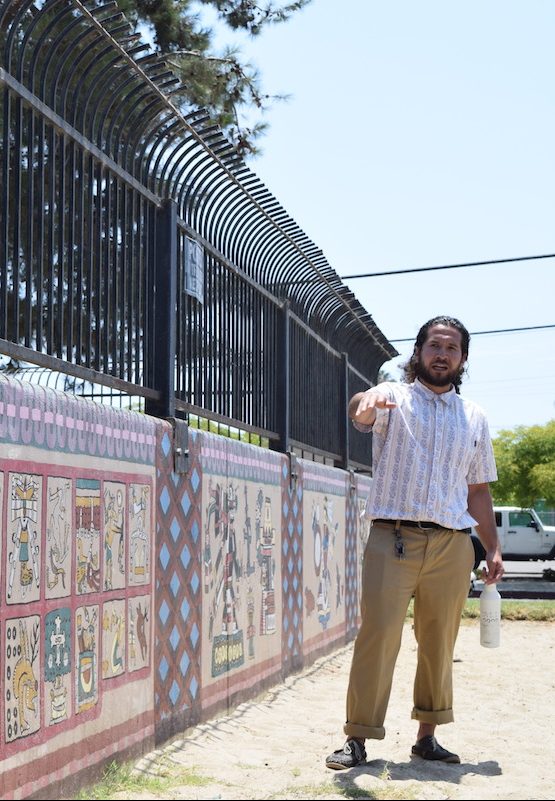Occupy Ortega Park Amplifies Community Support for Murals
Community-Led Event Brings Neighborhood Together to Raise Awareness

There have been several polarizing views about what should be done with the historical murals at Santa Barbara’s Ortega Park for its proposed renovation, but the voices of those that grew up in the neighboring community and those that live there now are clear: “We want the murals to stay.”
On Sunday, this neighborhood community gathered in the Eastside park for Occupy Ortega Park, an event meant to amplify these voices and educate those unfamiliar with the deep history of the murals that give the park its unique flavor.
Michael Montenegro, community leader, activist, and curator behind @chicanoculturesb — an Instagram page that explores Santa Barbara’s Chicano history through informative posts and community-led discourse — organized Sunday’s event, which featured artists and vendors Sin Fin Designs, @oxy.airbrush, and Children of the Abyss, along with music by local Latin-fusion funk band Buena Onda.
“[Ortega Park] was an undesirable spot,” Montenegro said, leading a tour around the park’s many Chicano- and Indigenous-inspired murals. “Only raza would live here.”
Chicano muralism arose from the Chicano Civil Rights Movement, set off by the El Movimiento in the early 1960s and creating a culture of community-based murals and artworks across Southern California. According to a mural evaluation report by Site & Studio Conservation that was recently accepted through the Historic Landmarks Commission, the Ortega Park murals are particularly noteworthy because they were one of a few Chicano murals officially sanctioned in the 1970s by the city of Santa Barbara in partnership with community center La Casa de la Raza and the people of the neighborhood itself.
Mark Alvarado, founder and director of the One Community Bridge Project, an organization that helped bring awareness when the murals were slated for destruction a year ago, says that any updates to the park must be “family friendly and culturally representative.” He said that original plans that failed to consider the murals sparked the organization’s push to save them.
“We advocated, essentially, centering the murals,” Alvarado said. “We kind of woke up a segment of the community that was like, hey, I grew up here.”
He credits Councilmember Alejandra Gutierrez for continuing the fight from inside the city government. “She really showed leadership and guts,” he said.
Sign up for Indy Today to receive fresh news from Independent.com, in your inbox, every morning.
Gutierrez said she became aware of the community’s passion for the park’s murals when the plan was “almost set to be done,” and she learned many who grew up in the area did not want them to be removed. She said she hopes this will bring changes to how the city handles community outreach to ensure the people have input before plans are finalized.
“We can’t continue to do community outreach the way we do,” Gutierrez said. “We work with public funds. We work for the people.”
Muralists Armando Rascón, Armando Vallejo, and Manuel Unzueta were instrumental in the painting of the murals, along with La Casa de la Raza, which was newly formed in 1969. Unzueta worked with youth to create some of the art, allowing them to paint alongside him and become part of the park forever.
Diana Cabral, an Eastside native who is related to Unzueta, drove down from the San Fernando Valley to support the cause. She runs Sin Fin Designs, where she creates and sells handmade crafts, clothing, and accessories inspired by Chicano art and culture.
“You can’t just erase history,” said Cabral. “This is history, through the murals.” She said that they are more than just paint on walls, but represent “sacrifice and effort” to those who made them happen.
Andi Garcia, who helped Montenegro organize the event, grew up on the Eastside and can recall spending much of her youth in the park. She has memories of being a kid when Unzueta put a paintbrush in her hand. She said the city views the park as rundown, and cites the removal of the picnic tables and benches in 2016 out of concern that “transients” were congregating there as evidence that the city doesn’t understand who really uses the park. “The ones that suffer most are the families,” Garcia said.
One of the reasons behind the Occupy Ortega Park events, she said, is to remind the city that the community still uses the park. “They thought we forgot,” Garcia said. “We didn’t forget.”
Part of why the park is thought to be forgotten is the lack of events and gatherings, something Montenegro said is directly related to accessibility. “Developers have said no one uses the park.” He said that previous generations would hold parties, weddings, and quinceañeras in the park’s Welcome House, but current prices are not feasible for the working-class people who live in the area. “The prices are financially inaccessible.”
The latest recommendations from the mural evaluation report state that the murals that are in good condition be kept as is, or relocated within the park, and those that are significantly damaged be “re-created” or “reenvisioned” with the community’s input.
UPDATE: This story was updated 7/27/21 to note that Andi Garcia also helped to organize the event.
Support the Santa Barbara Independent through a long-term or a single contribution here.



